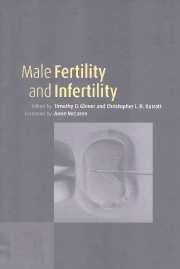Book contents
- Frontmatter
- Contents
- List of contributors
- Foreword by Anne McLaren, FRS
- Preface
- Acknowledgements
- Part 1 Biological perspectives
- 1 The evolution of the sexual arena
- 2 The role of sperm competition in reproduction
- 3 Sperm production and delivery in mammals, including man
- 4 The local control of spermatogenesis
- 5 Some misconceptions of the human epididymis
- 6 Transport of spermatozoa to the egg and fertilization success
- 7 Changes in human male reproductive health
- Part 2 Implications of the new technologies
- Index
4 - The local control of spermatogenesis
from Part 1 - Biological perspectives
Published online by Cambridge University Press: 09 August 2009
- Frontmatter
- Contents
- List of contributors
- Foreword by Anne McLaren, FRS
- Preface
- Acknowledgements
- Part 1 Biological perspectives
- 1 The evolution of the sexual arena
- 2 The role of sperm competition in reproduction
- 3 Sperm production and delivery in mammals, including man
- 4 The local control of spermatogenesis
- 5 Some misconceptions of the human epididymis
- 6 Transport of spermatozoa to the egg and fertilization success
- 7 Changes in human male reproductive health
- Part 2 Implications of the new technologies
- Index
Summary
The major features of spermatogenesis
It is not possible to undertake a discussion of the regulation of spermatogenesis without properly understanding the key steps in sperm production, and details of this process have been extensively reviewed (de Kretser & kerr, 1994: Sharpe, 1994). In the adult mammal, spermatogenesis, when fully established, can be subdivided into three essential phases: (1) the replication of stem cells, (2) the meiotic process, and (3) spermiogenesis.
Detailed understanding of the precise cell type (s) that constitutes the core stem in the testis is poor. In most species, it is recognized that one of the spermatogonial subclasses constitutes the basic stem cells, which, after certain treatments, can repopulate the seminiferous epithelium provided they are left physiologically intact. These spermatogonia, the cell types which must replace themselves and give rise to cohorts of germ cells that commence the meiotic process, divide by mitosis. The number of differing spermatogonial subtypes that have been identified varies between species as does the nature of the cytological classification that has been employed in their definition. In general, three spermatogonial subtypes can be identified – spermatogonia A, intermediate spermatogonia and type B spermatogonia – which appear to form a hierachical lineage, with the type B spermatogonia forming the cell type that will progress into meiosis.
The cytological criteria that are used to classify spermatogonia are very dependent on the type of fixation, which does not make identification and quantification easy.
- Type
- Chapter
- Information
- Male Fertility and Infertility , pp. 56 - 84Publisher: Cambridge University PressPrint publication year: 1999



